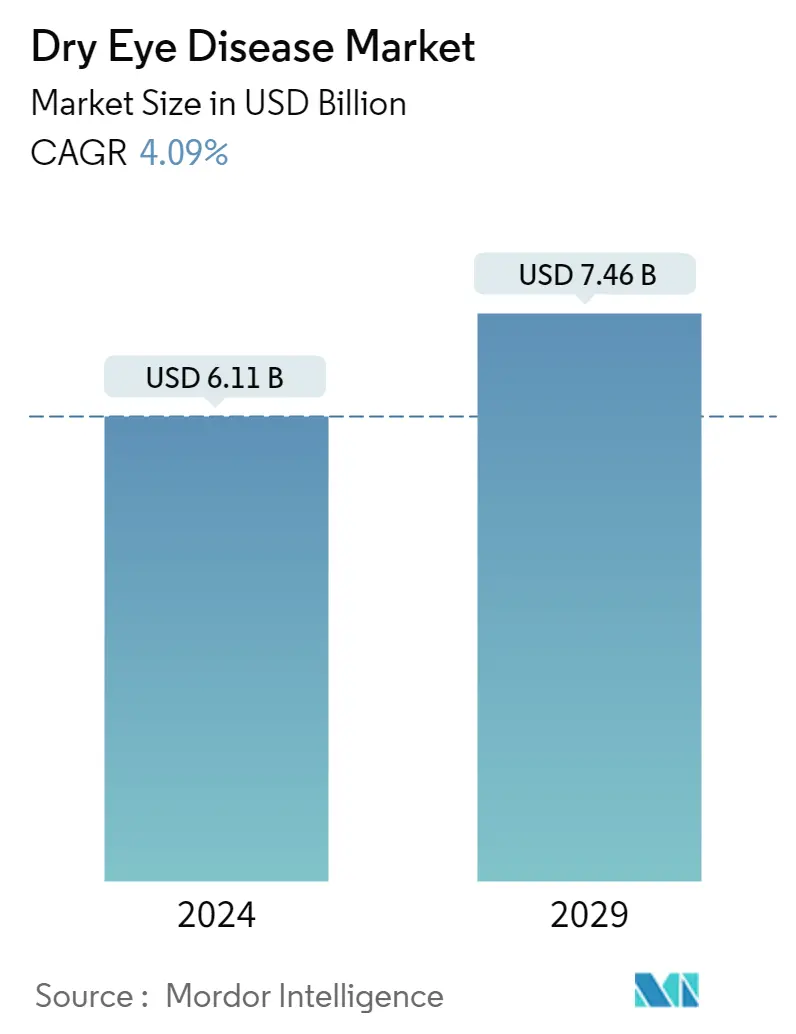
| Study Period | 2021 - 2029 |
| Base Year For Estimation | 2023 |
| Market Size (2024) | USD 6.11 Billion |
| Market Size (2029) | USD 7.46 Billion |
| CAGR (2024 - 2029) | 4.09 % |
| Fastest Growing Market | Asia-Pacific |
| Largest Market | North America |
Major Players
*Disclaimer: Major Players sorted in no particular order |
Dry Eye Disease Market Analysis
The Dry Eye Disease Market size is estimated at USD 6.11 billion in 2024, and is expected to reach USD 7.46 billion by 2029, growing at a CAGR of 4.09% during the forecast period (2024-2029).
The impact of COVID-19 on the Dry Eye Market was adverse in the initial phases owing to the cancellations in elective procedures including diagnosis and eye treatments along with supply chain disruptions of medications worldwide. During the lockdown, people's screen time (irrespective of their age) increased significantly, which had a severe impact, and an increase in ophthalmic disorders was observed. For instance, a research study published in December 2021 stated that both Dry Eye Disease (DED) patients and healthy participants up to the age of 60 experienced worsening dry-eye symptoms during the COVID-19 lockdown due to increased visual display terminal (VDT) period. The study also reported that younger persons had more severe Dry Eye problems than older respondents, particularly during the lockdown. Therefore, the Dry Eye Disease Market gained traction as the restrictions were lifted. Since the pandemic led to an increase in Dry Eye Disease cases globally, boosting the Dry Eye Medication Market, it is expected to propel the market growth during the forecast period.
Several factors, such as aging, decreasing supportive hormones, systemic inflammatory diseases, ocular surface diseases, or surgeries that affect the cholinergic nerves, which stimulate tear secretion, may be associated with the rising prevalence of Dry Eye Syndrome, spurring the growth of the Dry Eye Treatment Devices Market. For instance, an article published in Frontiers in Medicine Journal stated that among people who require eye care, DED has become the fifth most prevalent ocular condition in women and ninth most prevalent in men in the United States in 2021. Additionally, an article published in the Journal of the British College of Ophthalmic Opticians stated that the global prevalence of Dry Eye Disease was estimated at 11.59% in 2021. Thus, the burden of DED is anticipated to drive the growth of the Dry Eye Syndrome Market in the country.
Furthermore, a research study published in BMC Ophthalmology Journal in May 2021 conducted a survey of 452 participants in Dubai, out of which 63.7% were females. The prevalence of Dry Eyes in Dubai was estimated to be 62.6% in the surveyed population, with 42% having severely dry eyes. A significant percentage of the global population suffers from Dry Eye Disease. The disease is particularly more common among women than in men. This factor is responsible for propelling the Dry Eye Disease Market growth in the analysis period.
The strategic initiatives adopted by the key market players such as product launches, approvals, and partnerships in the Dry Eye Disease Treatment Market are also driving growth. For instance, in November 2021, I-MED Pharma USA launched I-DROP MGD, a preservative-free, viscoadaptive Eye Drop containing a lipid designed to enhance and stabilize all three layers of the tear film to treat Dry Eye. Such developments are estimated to augment the market growth during the forecast period.
However, the high cost of specialty Dry Eye products with complex reimbursement scenarios and the availability of alternative therapies are likely to impede the Dry Eye Products Market growth over the forecast period.
Dry Eye Disease Industry Segmentation
As per the scope of the report, dry eye disease refers to the disturbance of the lacrimal functional unit, which comprises the lacrimal glands, ocular surface (cornea, conjunctiva, and meibomian glands), and lids, along with the sensory and motor nerves that connect them. The Dry Eye Disease Market is Segmented by Product, Artificial Tears, Anti-inflammatory Drugs (Cyclosporine, Corticosteroid, and Other Anti-inflammatory Drugs), Punctal Plugs, Secretagogues, and Other Products, Distribution Channels (Hospital Pharmacies, Independent Pharmacies, and Drug Stores, and Online Pharmacies), and Geography (North America, Europe, Asia-Pacific, Middle-East and Africa, and South America). There are various ocular manifestations that use several dry eye treatment products. The market report also covers the estimated market sizes and trends for 17 countries across major regions globally. The report offers the value in USD million for the above segments.
| Artificial Tears | |
| Anti-inflammatory Drugs | Cyclosporine |
| Corticosteroid | |
| Other Anti-inflammatory Drugs | |
| Punctal Plugs | |
| Secretagogues | |
| Other Products |
| Hospital Pharmacies |
| Independent Pharmacies and Drug Stores |
| Online Pharmacies |
| North America | United States |
| Canada | |
| Mexico | |
| Europe | Germany |
| United Kingdom | |
| France | |
| Italy | |
| Spain | |
| Rest of Europe | |
| Asia-Pacific | China |
| Japan | |
| India | |
| Australia | |
| South Korea | |
| Rest of Asia-Pacific | |
| Middle East and Africa | GCC |
| South Africa | |
| Rest of Middle East and Africa | |
| South America | Brazil |
| Argentina | |
| Rest of South America |
Dry Eye Disease Market Size Summary
The dry eye disease market is poised for significant growth over the forecast period, driven by an increasing prevalence of the condition globally. The market's expansion is attributed to various factors, including the aging population, hormonal changes, and systemic inflammatory diseases, which contribute to the rising incidence of dry eye-related disorders. The COVID-19 pandemic initially disrupted the market due to elective procedure cancellations and supply chain issues; however, it also led to an increase in dry eye cases as screen time surged during lockdowns. This surge in cases is expected to propel market growth as restrictions ease. The market is characterized by strategic initiatives from key players, such as product launches and partnerships, which are further driving growth. Despite challenges like high costs and complex reimbursement scenarios for specialty products, the demand for corticosteroids and other anti-inflammatory medications remains strong, particularly among the elderly, who are more prone to eye-related disorders.
North America is anticipated to hold a significant share of the dry eye disease market, supported by the high prevalence of the condition and the availability of effective solutions. The region's market growth is bolstered by novel drug launches and the increasing demand for therapeutics due to widespread digital screen use. The competitive landscape is fragmented, with numerous global and regional players, including AbbVie Inc., Alcon Inc., and Bausch Health Companies Inc., among others. These companies are actively involved in product development and clinical trials to enhance their market presence. The introduction of new products, such as EYSUVIS and Cequa, is expected to provide a competitive edge in the market. Overall, the dry eye disease market is set for steady growth, driven by demographic trends, technological advancements, and strategic market activities.
Dry Eye Disease Market Size - Table of Contents
1. MARKET DYNAMICS
- 1.1 Market Overview
-
1.2 Market Drivers
- 1.2.1 Rising Burden of Dry Eye Disease
- 1.2.2 Technological Advancements and Emergence of Novel Diagnostic Tools
-
1.3 Market Restraints
- 1.3.1 High Cost of Specialty Dry Eye Products with Complex Reimbursement Scenario
- 1.3.2 Availability of Alternative Therapies
-
1.4 Porter's Five Forces Analysis
- 1.4.1 Threat of New Entrants
- 1.4.2 Bargaining Power of Buyers/Consumers
- 1.4.3 Bargaining Power of Suppliers
- 1.4.4 Threat of Substitute Products
- 1.4.5 Intensity of Competitive Rivalry
2. MARKET SEGMENTATION (Market Size by Value - USD million)
-
2.1 By Product
- 2.1.1 Artificial Tears
- 2.1.2 Anti-inflammatory Drugs
- 2.1.2.1 Cyclosporine
- 2.1.2.2 Corticosteroid
- 2.1.2.3 Other Anti-inflammatory Drugs
- 2.1.3 Punctal Plugs
- 2.1.4 Secretagogues
- 2.1.5 Other Products
-
2.2 By Distribution Channel
- 2.2.1 Hospital Pharmacies
- 2.2.2 Independent Pharmacies and Drug Stores
- 2.2.3 Online Pharmacies
-
2.3 Geography
- 2.3.1 North America
- 2.3.1.1 United States
- 2.3.1.2 Canada
- 2.3.1.3 Mexico
- 2.3.2 Europe
- 2.3.2.1 Germany
- 2.3.2.2 United Kingdom
- 2.3.2.3 France
- 2.3.2.4 Italy
- 2.3.2.5 Spain
- 2.3.2.6 Rest of Europe
- 2.3.3 Asia-Pacific
- 2.3.3.1 China
- 2.3.3.2 Japan
- 2.3.3.3 India
- 2.3.3.4 Australia
- 2.3.3.5 South Korea
- 2.3.3.6 Rest of Asia-Pacific
- 2.3.4 Middle East and Africa
- 2.3.4.1 GCC
- 2.3.4.2 South Africa
- 2.3.4.3 Rest of Middle East and Africa
- 2.3.5 South America
- 2.3.5.1 Brazil
- 2.3.5.2 Argentina
- 2.3.5.3 Rest of South America
Dry Eye Disease Market Research FAQs
How big is the Dry Eye Disease Market?
The Dry Eye Disease Market size is expected to reach USD 6.36 billion in 2025 and grow at a CAGR of 4.09% to reach USD 7.77 billion by 2030.
What is the current Dry Eye Disease Market size?
In 2025, the Dry Eye Disease Market size is expected to reach USD 6.36 billion.


